July 15, 2013
In Memoriam: Dawn Dickinson
Wild Lands Advocate article, April/May 2013, by Dennis Baresco. Dawn Dickinson, dedicated biologist, zoologist and…


The biophysical features of Kirkpatrick Prairie include beaver ponds, moist meadows, and parkland.
The Kirkpatrick Prairie is a highly variable natural area with a largely intact stretch of native prairie.
As Alberta has experienced significant losses of important native prairie habitat, it is imperative that further surface disturbance is excluded from the remaining native prairie.
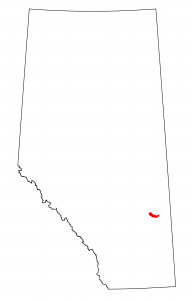 |
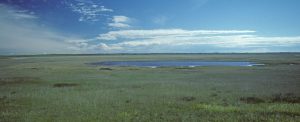 |
Kirkpatrick Lake borders the western edge of this AWA’s Kirkpatrick Prairie Area of Concern and is a lake of significant waterfowl production. Photo © C. Wallis
AWA’s Kirkpatrick Prairie Area of Concern encompasses 413 km2 of native grasslands in Southern Alberta, including significant fescue prairie communities. The area draws its international significance from the intactness of its prairie habitat, and that it serves as important staging and breeding habitat for birds.
The Kirkpatrick Prairie has an estimated 50-75% native prairie remaining, making it an internationally significant area. Some notable biophysical features in the Kirkpatrick Prairie include:
At this time, there are no federal or provincial protected areas within Kirkpatrick Prairie, although the area surrounding Kirkpatrick Lake is designated as an Important Bird Area (IBA), which does not provide any formal protection.
Kirkpatrick Prairie is a patchwork of tame pasture and native prairie, spread across both private and public lands.
Public lands within Kirkpatrick Prairie are classified under Alberta’s White Area, which are part of Alberta’s agricultural landscape. In addition to agricultural developments, public lands within the White Area are also managed for water, wildlife habitat, resource extraction and recreation. Relevant legislation for managing and administering public lands includes: the Public Lands Act and the South Saskatchewan Regional Plan.
AWA’s Kirkpatrick Prairie Area of Concern encompasses 413 km2 of native grasslands in Southern Alberta, including significant fescue prairie communities. The area draws its international significance from the intactness of its prairie habitat and its important staging and breeding areas for birds. The area is located two and a half hours west of Red Deer via Highway 12, south of the town of Veteran.
The Kirkpatrick Prairie has an estimated 50-75% native prairie remaining, making it an internationally significant area. Some notable biophysical features in the Kirkpatrick Prairie include:
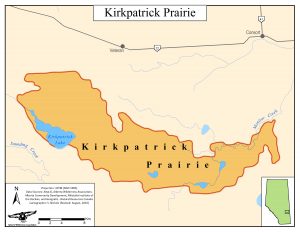 AWA’s Kirkpatrick Area of Concern. MAP © AWA FILES: JPG | PDF
AWA’s Kirkpatrick Area of Concern. MAP © AWA FILES: JPG | PDF
Kirkpatrick Prairie is located within the Sounding Creek watershed within the larger South Saskatchewan River basin. Sounding Creek is a closed basin, or a watershed that does not drain out to the ocean. The watershed will eventually drain into Manitou Lake in Saskatchewan, where the lake loses its water to evaporation.
Kirkpatrick Lake, located on the western edge of AWA’s Kirkpatrick Area of Concern, is a saline lake. The lake holds internationally significant bird habitat for staging and breeding.
The surface geology of Kirkpatrick Prairie consists of fine to medium grained sand and silt deposited during the Pleistocene and Holocene stages of the Quaternary period. The area includes longitudinal and parabolic dunes that have been scoured by blowouts.
Kirkpatrick Prairie contains a large internationally significant area, designated for the important breeding and staging habitat for birds that surrounds Kirkpatrick Lake. Kirkpatrick Prairie also contains areas of national significance due to the intactness of the area’s native prairie habitat.
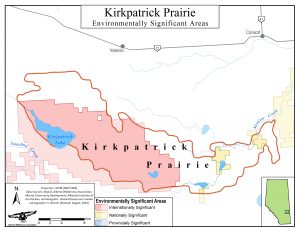 Kirkpatrick Area of Concern ESAs. MAP © AWA FILES: JPG | PDF
Kirkpatrick Area of Concern ESAs. MAP © AWA FILES: JPG | PDF
Kirkpatrick Prairie is found within the Northern Fescue and Dry Mixedgrass Natural Subregions of Alberta’s Grasslands Natural Region.
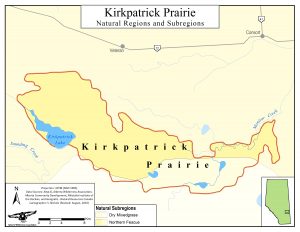
Kirkpatrick Area of Concern ESAs. MAP © AWA FILES: JPG | PDF
Northern Fescue
The vegetation of the Northern Fescue Natural Subregion represents a transitional condition between prairie and parkland, displaying characteristics of both regions. This subregion is dominated by plains rough fescue, Alberta’s provincial grass. The grasses on the driest sites include blue grama, northern wheat grass, sand grass, and June grass. Moister sites contain western porcupine grass, plains rough fescue, northern wheatgrass, and porcupine grass. Other plant species include balsam poplar, aspen, plains cottonwood, willow, sedge, bulrush, and common cattail.
Dry Mixedgrass
“Mixedgrass” refers to the mixture of short and mid-height grasses. The most widespread grasses in this subregion are blue grama, needle-and-thread, June grass, and western wheat grass. In spring and summer, many species of wildflowers are interspersed among the grasses. Shrubs include silver sagebrush, silverberry (also known as wolf willow), buckbrush, and prickly rose. Along river valleys, tall forest and shrub communities thrive, including plains cottonwood, willow, and thorny buffaloberry.
Tens of thousands of birds migrate through the area surrounding Kirkpatrick Lake each season, giving the Kirkpatrick Prairie its status as an Important Bird Area (IBA). Migrating birds include Northern pintails and and snow geese.
The area also serves as important habitat for breeding birds, including Baird’s sparrow, loggerhead shrike, Sprague’s pipit, sharp-tailed grouse, and upland sandpipers.
Kirkpatrick Prairie has key habitat for mule deer, and contains other large mammals such as white-tailed deer, moose and elk.
Seasonal hunting is permitted within Kirkpatrick Prairie as it falls within one of Alberta’s Wildlife Management Units (WMUs).
Oil and gas poses a number of threats to the intact native grasslands of Kirkpatrick Prairie. Given the scarcity of native grasslands in Alberta and their limited protective status, oil and gas exploration threatens to convert what grasslands remain. In addition to surface disturbance, oil and gas development introduces invasive species into the area through roads and other forms of linear disturbance; invasive species will outcompete native grassland species, further reducing native vegetation in Alberta’s Grasslands Natural Region.
AWA has written to the Government of Alberta on two occasions regarding proposed oil and gas leases within the sensitive grassland habitat of Kirkpatrick Prairie.
As Alberta has experienced significant losses of important native prairie habitat, it is imperative that we limit surface disturbance of remaining native prairie. Alberta’s native prairie is at risk of gradual conversion to cropland. Legislated protected of Kirkpatrick Prairie would help to protect its intact grassland habitat from further disturbance.
AWA writes to the provincial Minister of Energy regarding the fate of several leases in the Kirkpatrick Prairie Area of Concern. The letter presents another plea to protect more of Alberta’s diverse Natural Regions and Subregions.
AWA writes to the provincial Minister of Energy to oppose the sale of several leases in the Kirkpatrick Prairie Area of Concern.
On March 31, Kirkpatrick Native Prairie is identified as an environmentally significant area (ESA) for the presence of ground moraines, sandy plains, dune fields, streams, wet meadows, and alkali wetlands. The site has the potential for becoming a level 1 Natural History Theme (NHT), as conditions found in the area are under-represented in current protected areas. The area which has been identified as Northern Fescue and Dry Mixedgrass sub-regions is 50-75% native prairie with the remaining 25-50% representing patches of cultivation and lightly grazed areas. The land is excellent habitat for rare avian species.
July 15, 2013
Wild Lands Advocate article, April/May 2013, by Dennis Baresco. Dawn Dickinson, dedicated biologist, zoologist and…
June 27, 2013
In April 2012, the Government of Canada announced the divestiture of the former PFRA community…
June 26, 2013
Last year, the Canadian government announced the divestiture of the former PFRA community pastures. The…
June 24, 2013
Letter from AWA to the Kneehill County planning department registering opposition to having the Badlands…
June 18, 2013
A report prepared for the Ranchers Stewardship Alliance Inc. with the intent of helping inform…
June 14, 2013
The closure of the Onefour Research Farm is part of plans the federal government has…
June 14, 2013
The federal government recently announced its plan to close the Onefour Research Station in southeastern…
June 13, 2013
AWA asks Premier Redford and Prime Minister Harper to ensure that the Onefour Research Farm…
January 28, 2013
Wild Lands Advocate update, December 2012, by Katie Rasmussen. AWA has publicly supported private members…
November 30, 2012
The seven-group Suffield Coalition today applauded the government’s decision to deny approval of Cenovus’ (previously…
November 24, 2012
As we reflect on 2012 and AWA’s 2012 conservation priorities and progress, we will be…
October 31, 2012
Wild Lands Advocate article, October 2012, by Sean Nichols. The new minister of Alberta Tourism,…
